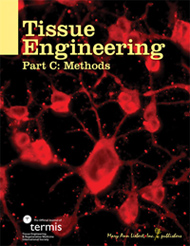Cryopreserving cells
Oeiras, 13.10.09
A new method for cryopreservation of monolayer cell cultures has been devised by researchers from the Animal Cell Technology Unit and co-workers. The work describing a novel cryopreservation strategy based on cell entrapment beneath a layer of clinical-grade, ultra-high viscosity permeable alginate hydrogel was selected to illustrate the cover of the September issue of the journal Tissue Engineering.
In this study, two cell lines with distinct structural and functional characteristics, mouse neuroblastoma N2a and human colon adenocarcinoma Caco-2, were used as model systems with cell–cell and cell–matrix interactions. Combining different strategies based on cell entrapment in ultra-high viscous alginate and serum-free CryoStorTM solution lead to optimal protocols for the cryopreservation of adherent cells in a fully differentiated state.
 |
Cryopreservation provides great benefits to a wide variety of mammalian cell–based applications, including reproductive embryology, regenerative and reparative medicine, and biomedical research, or for in vitro drug screening and toxicology testing. But such benefits can only be fully accomplished if cell function is maintained during the cryopreservation process. Commonly applied cryopreservation protocols, developed for simple cell suspensions, are not straightforward when it comes to complex systems (cell monolayers or tissues) with cell detachment and membrane damage often observed. The protocols devised in this work enabled the retention of cell membrane and whole monolayer integrity, metabolic activity, and cellspecific function-differentiated state, a major requirement for clinical and pharmacological applications of cell lines. |
Making it possible to cryopreserve large numbers of viable and functional adherent cells on micro-plates eliminates the time consuming process of inoculation and expansion from a frozen vial of cells, thus reducing time between cell storage and use both in research labs and clinical settings. It also facilitates the creation of cellular clone banks, reducing batch-to-batch variability and normalizing passage age, essential factors for reliable results in pharmacological testing. Successful cryopreservation protocols, such as the one described in this paper are likely to support the implementation of routine cryopreservation practices during preparation of engineered cells and tissues for clinical applications and enable the immediate availability of cells grown on biocompatible matrices for transplantation (e.g., spinal cord, cartilage, skin, cornea, etc).
Original article
Tissue Engineering Part C: Methods. September 2009, 15(3): 373-386.
Cryopreservation of Adherent Cells: Strategies to Improve Cell Viability and Function After Thawing
Rita Malpique, Friederike Ehrhart, Alisa Katsen-Globa, Heiko Zimmermann, Paula M. Alves







